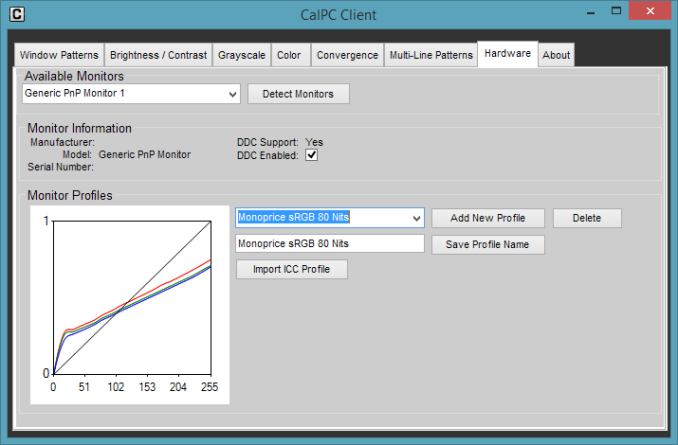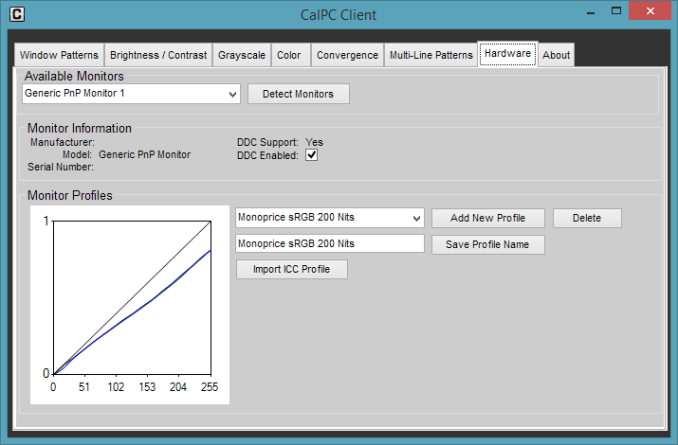Monoprice Zero-G Slim 27" IPS Monitor Review
by Chris Heinonen on August 26, 2013 12:00 AM ESTAll calibrations are done using CalMAN 5.1.2 software with an i1Pro meter and a C6 meter. Our targets are 200 cd/m^2 and gamma 2.2 for the pre-calibration and post-calibration measurements with the sRGB colorspace. We also try for 80 cd/m^2 and the sRGB gamma curve to see how well a display handles a more demanding professional setting.
| Pre-Calibration |
Post-Calibration, 200 cd/m^2 |
Post-Calibration, 80 cd/m^2 |
|
|---|---|---|---|
| White Level (cd/m^2) | 325.75 | 199.38 | 81.14 |
| Black Level (cd/m^2) | 0.373 | 0.335 | 0.322 |
| Contrast Ratio | 874:1 | 595:1 | 252:1 |
| Gamma (Average) | 1.309 | 2.195 | 3.051 |
| Color Temperature | 6744K | 6584K | 6648K |
| Grayscale dE2000 | 7.853 | 0.589 | 1.100 |
| Color Checker dE2000 | 7.611 | 0.942 | 1.000 |
| Saturations dE2000 | 5.413 | 1.083 | 0.995 |
Running the Zero-G at Contrast 50 and Brightness 50 with the sRGB preset, these are the best numbers I could obtain without a calibration. Since we are targeting 200 cd/m^2 and not 325 cd/m^2, that makes the numbers worse since we are expecting it to be 200 cd/m^2.
We see the gamma is incorrect and there are large grayscale errors. If I adjust the Brightness to 0 we see a gamma that is still wrong, and a blue color shift that gives us an average color temp of 8797K. The contrast ratio also falls to 580:1 and overall performance is worse.
If you only look at the Color Gamut chart, everything looks nice. Switch to the Saturations chart and you’ll see that the 40% red saturation target is past even where 60% should be. Blue and Magenta are over-saturated as well. The color checker chart confirms these saturation errors. This is why using only the standard gamut chart, as many people and print magazines do, provides little insight into actual performance.
Out of the box, the Monoprice Zero-G offers weird, strange performance that I haven’t seen in a long time. It also offers proof of why a panel in a monitor is only a small part of what leads to a quality display.
Calibrate the Monoprice and you have a totally different display. Look at the numbers and they are virtually perfect. If you are targeting 200 cd/m^2 you will have trouble doing better except with contrast ratio and black level. Those are still worse than what other monitors can produce.
Calibrate for 80 cd/m^2 and an sRGB target and you’ll see that performance isn’t quite as good as the 200 cd/m^2 target. The reason is the brightness control. Below are images from the CalPC client that CalMAN uses to calibrate. You can see the default line (in black) and the adjustments made to Red, Green and Blue channels for different output levels. Ideally these should track the default line.
On the Monoprice they start out much lower on the right. Because we have to correct for the brightness levels in the LUT, instead of using the display controls, we lose dynamic range and contrast ratio. The black level doesn’t change but the white level is dropping. We also don’t have as much room for adjustment for the gamma curve, which is why the sRGB one suffers.
CalMAN has corrected a lot of the flaws in the Monoprice compared to the default settings, but it has to take a large hit to contrast ratio to do so.






























79 Comments
View All Comments
arcanes - Monday, August 26, 2013 - link
It was. Because Skyrim and Borderlands 2 are not the games I would call demanding. So I guess if you want to play last gen game engines at 120hz@2560x1440 you will be fine. I would rather play at 60hz and get a stable frame rate with higher quality settings. Don't get me wrong, I would love to play at 120hz ,but with the graphics engines/video cards of today I would stick with 60hz. Btw the Catleap 2B looks nice. Recommended?vLsL2VnDmWjoTByaVLxb - Monday, August 26, 2013 - link
Because you can play at 61-120fps, which a 60 Hz LCD can never ever do. It's not just about the top frames per second.Also, you buy these monitors for much longer than you buy PC's. The gaming PC's 3 years from now will be able to play Crysis 3 at 120 fps with ease.
DanNeely - Monday, August 26, 2013 - link
I wouldn't hold my breath on PC gaming hitting 120hz within a few years on single GPU setups. With the new consoles lifting low end target GPU performance up several orders of magnitude, I expect a major jump in requirements needed to max setting as well. Needing SLI/xFire to game at high/2560/60hz again wouldn't surprise me at all.arcanes - Monday, August 26, 2013 - link
My thinking as well. That is why I'm skeptical about 120hz@2560x1440 gaming in the future.DanNeely - Monday, August 26, 2013 - link
I'm sure it'll happen; it just won't be cheap anytime soon. It's not any more pixels than 4k @ 60hzblackoctagon - Tuesday, August 27, 2013 - link
The people out there who have spent $650-2000 on GPU hardware are admittedly the minority, but plenty of them exist. For these people, their rigs are effectively wasted when gaming on 60Hz 2560x1440 monitors or 120Hz 1920x1080 monitors.FYI I game on a 2560x1440 monitor OC'd to 120Hz, and I just have a single 7970. How do I get 120fps? Buy....(drumroll)...adjusting the in-game settings! I start by minimising or disabling AA and work from there. I prefer fluidity of motion over 'maxing' out graphics. So there you go, that's my reason.
name user - Monday, August 26, 2013 - link
Again I'd like to request 110/120hz overclocking support information in these reviews.After all, it was here reading Anandtech that I learned the benefits of 120hz several years ago, and have been chasing that feature ever since. I think it's strange that you guys don't even mention it anymore when you're the ones who sold me on the feature. I'm still sitting on 10 year old 19" LCDs because thanks to you I refuse to upgrade to anything but high hz monitors.
Koblek - Monday, August 26, 2013 - link
Check out Overlord monitors. It is an American company that sources 27" LG panels and a driver board that is easily overclocked to 120Hz. I got one a few weeks ago and it I was able to overclock to 120Hz easily using dual 7970s. BF3 looks great. It does not usually hit above 100Hz, but the experience is much smoother than just 60Hz.mikato - Monday, August 26, 2013 - link
I have heard of these a couple times but not much beyond something in a forum and then visiting their site. Any reviews from major sites?Koblek - Tuesday, August 27, 2013 - link
To be honest, I had only read about them on various forums before ordering one. The major drawback to these is that there is only one dual link DVI input and that's it. There is also no OSD. All color calibration needs to be done from your video card control panel. I loaded a color profile for the monitor from the Overlord forums and it's a good starting point. I have a Dell U2410 right next to it. Once I loaded the color profile, I used Catalyst Control Center to get the colors as close to the Dell as I could.Apparently, the lack of OSD and scaling makes the total response time very low. I brought it to my friend's and hooked it up to his 690. The 690 was able to drive most of his games at or near 120Hz and it looked incredible.
I would really like to see Anandtech do a review of these...